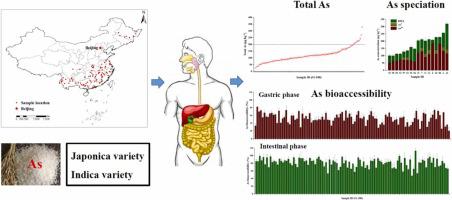Journal of Hazardous Materials ( IF 13.6 ) Pub Date : 2022-06-22 , DOI: 10.1016/j.jhazmat.2022.129431 Jia-Yi Chen 1 , Jing-Yu Zeng 1 , Song Ding 1 , Jie Li 2 , Xue Liu 3 , Dong-Xing Guan 1 , Lena Q Ma 1

|
As the staple food for Asian countries and with its ability in arsenic accumulation, rice consumption becomes a dominant pathway for As exposure to humans. Here, we collected 108 rice samples from local markets and online sources in 13 major rice-producing regions in China, and determined total As, As speciation and As bioaccessibility in the samples. Total As concentrations were 25–327 μg kg−1 (averaging 120), showing regional differences, with Hunan province being greater than other provinces at 180 vs 110 μg kg−1. In rice grains, inorganic As was the dominant species, being 39.9–88.5 (61.1%), but all being within the Chinese standard at 200 μg kg−1. Based on the modified physiologically-based extraction test (MPEBT), arsenic bioaccessibility in rice samples was 20.1–82.2 (52.3%) in the gastric phase and 47.2–113 (81.2%) in the intestinal phase. Strong positive correlation between total As and bioaccessible As suggested bioaccessible As was concentration-dependent. Based on the intestinal phase, the rice samples from northern region had lower As bioaccessibility than other regions (59.2 vs 83.2%), and Japonica variety had lower As bioaccessibility than Indica variety (71.1 vs 83.1%). This study suggests that rice from markets in China is safe, with their As concentrations and bioaccessibility showing regional and variety differences.



























 京公网安备 11010802027423号
京公网安备 11010802027423号